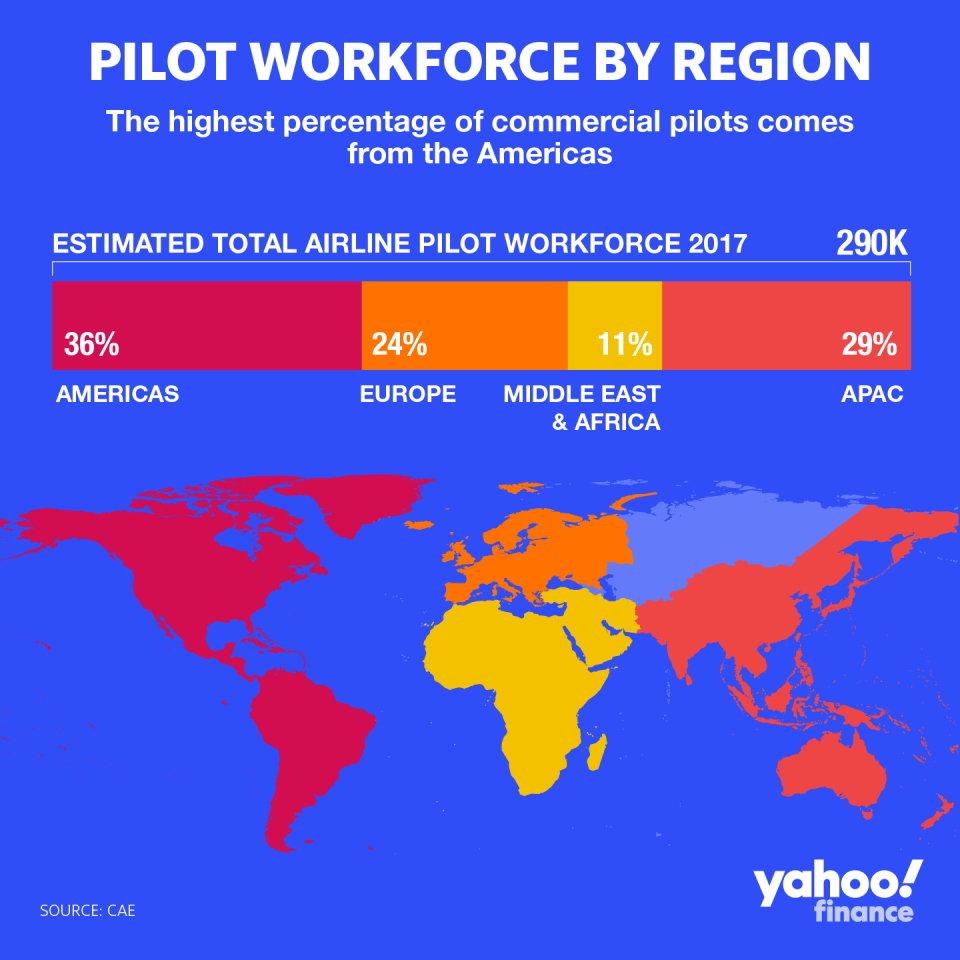Aviation professionals are seeing effects of pilot shortage: BAML survey
The next time your flight is delayed, it might just be that there’s no one to fly the plane. There’s a major pilot shortage in the U.S. In 1987, the number of pilots in the U.S. stood around 827,000. By 2018, that number decreased to just over 633,000, according to the Federal Aviation Administration (FAA).
And the problem is becoming more and more apparent, according to a Bank of America Merrill Lynch (BAML) survey done in conjunction with Aviation Week. The survey gauged the perceptions of 917 aviation professionals in the U.S. and Canada on the training and recruitment of pilots. Forty-six percent say they already see a pilot shortage, and 36% expect to see a shortage in the U.S. and Canada in the next five years.

One of the main drivers of the shortage is that the U.S., on average, has some of the oldest pilots in the world. This is especially true among those who fly transport. In 2002, the average U.S. transport pilot was 46, according to FAA data cited by BAML, and by 2018, that number rose to 51. BAML cited data analysis from the aviation training company CAE Inc. (CAE) showing that 42% of U.S. transport pilots are in the 50-64 years range.
BAML analyst Ronald Epstein tells Yahoo Finance that the modernization of the U.S. military has also played a role in the nation’s pilot shortage. “In North America, pilots have largely come out of the military. Still, largely due to the operating capability of military aircraft today, one aircraft can do more than an aircraft did 30 years ago. So because of that, you have fewer pilots,” he said.
Effect on consumers
A service shortage within any industry is sure to affect consumers, and the airline industry is no different. “Part of the cost structure of an airline is labor,” explains Epstein.
“As the number of pilots gets tighter, like with any labor market, when you get tighter labor, pay will go up ... You’ll probably see upward pressure on labor costs, and those labor costs will get passed through to consumers,” he added.

Boon for pilots
One group that stands to benefit the most from a pilot shortage are pilots themselves. As the law of supply and demand dictates, the fewer pilots, the more money they can command for their aviation services.
The median pay for airline and commercial pilots was $115,670 in 2018, according to the U.S. Bureau of Labor Statistics. However, the training cost to become a commercial pilot ranges from $80,000 to $100,000, BAML noted. BAML’s survey showed that 65% of commercial pilots, 68% of executive pilots, and 94% of freight pilots say that they are underpaid.
BAML says the pilot shortage underpins the bull market for companies with commercial training exposure, such as CAE, a Canadian company that specializes in training for civil aviation, defense and security, among others. The company currently owns 53% of the airline civil flight simulator market share.
Epstein says the pilot shortage affects both commercial and freight transportation. “It’s kinda like a Pez candy, the pilots — the men and women go up the canister and pop out the top. So, to the extent the regional airlines and the freight operators will need pilots too — and where are they pulling them from? So to the extent that it impacts the whole industry.”

Reggie Wade is a writer for Yahoo Finance. Follow him on Twitter at @ReggieWade.
Read more:
Nike unveils major sneaker innovation that was 10 years in the making
Boxing and business champ Oscar De La Hoya says his toughest fight took place outside the ring
'Skecherizing': Nike sues Skechers for allegedly 'free-riding' on its patented sneaker designs
96% of teachers personally pay for students' supplies: Survey
Read the latest financial and business news from Yahoo Finance
Follow Yahoo Finance on Twitter, Facebook, Instagram, Flipboard, LinkedIn, and reddit.

 Yahoo Finance
Yahoo Finance 
